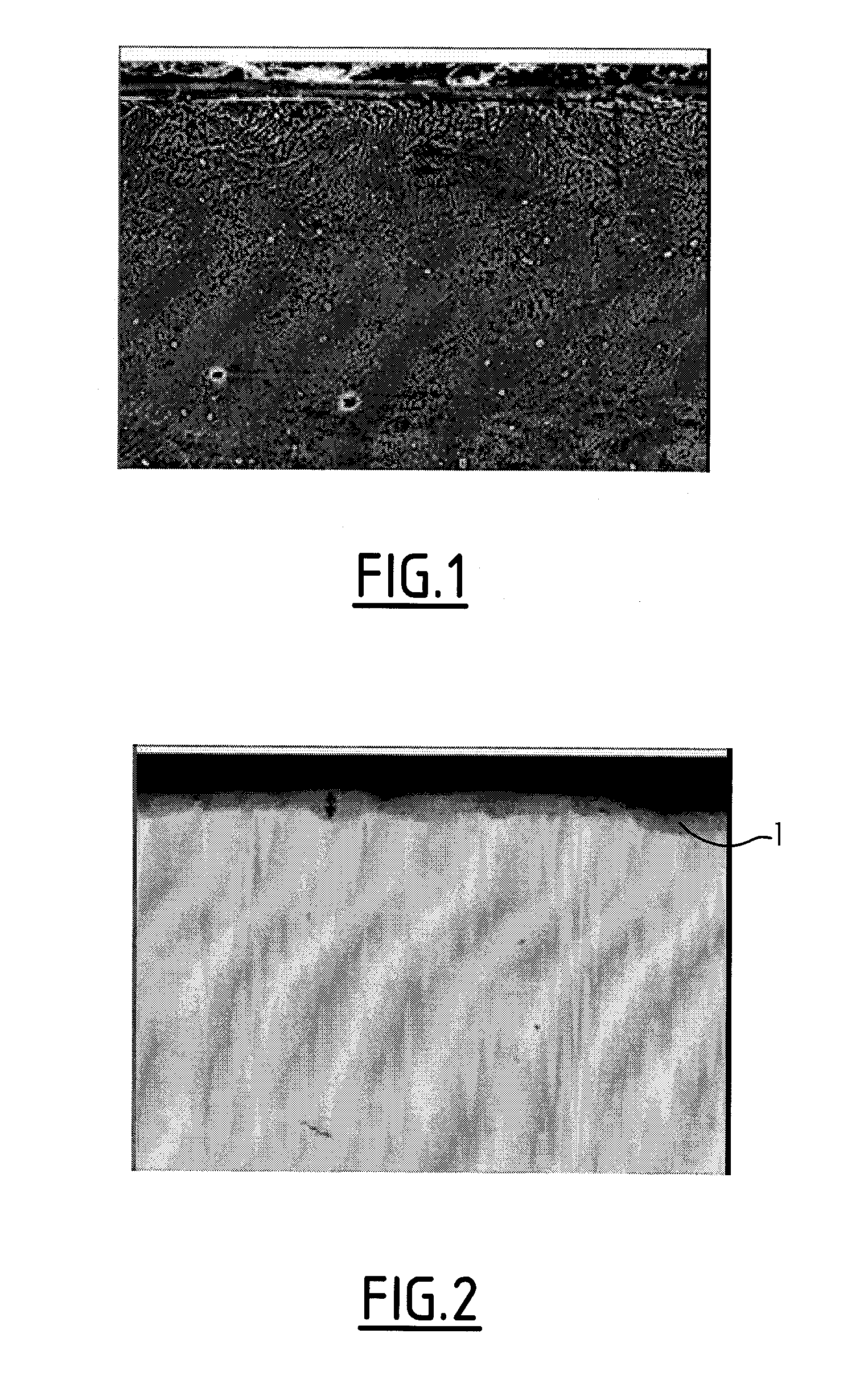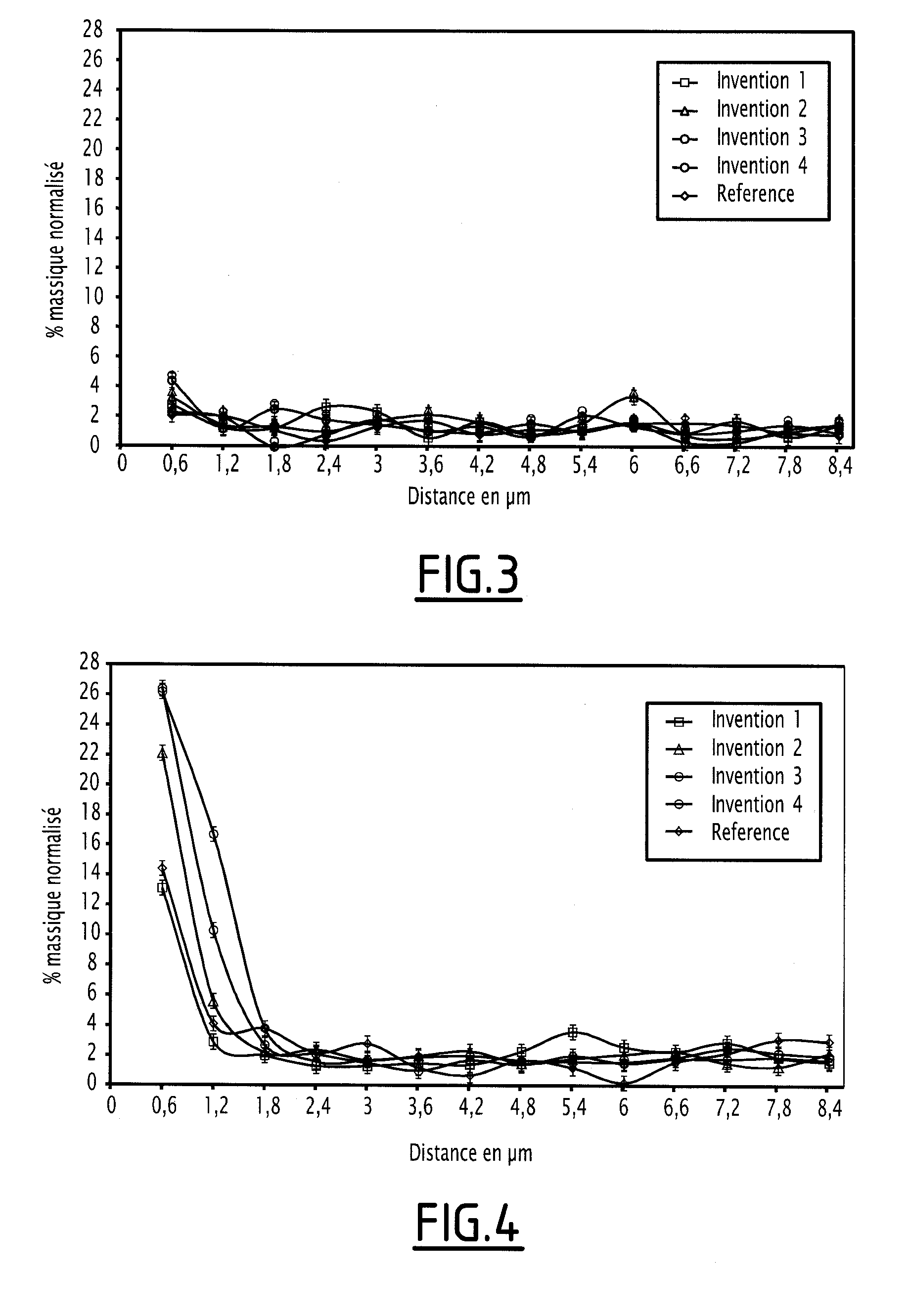It brings about a loss in
mass of the
metal and therefore a reduction in the outside
diameter of the
metal cladding, and also a substantial modification of the thermal characteristics thereof because
zircon is ten times less conductive than the
base metal.
It also diminishes the friction conditions of the fluid over the surface, which has a detrimental effect on the pressure drops of the
assembly.
During the production and
assembly operations of the fuel assemblies, superficial defects, such as scratches or local microdeformations, are formed on the claddings, produced in particular by friction to which the fuel rods are subjected when they are inserted in the skeleton of the fuel assembly.
Those initial superficial defects may aggravate subsequent deterioration of the
corrosion or wear behaviour.
Damage may also become evident during operation in the event of contact of the rod and the support elements thereof in the grids, and owing to migrating bodies which become trapped in the grids and strike the cladding.
This phenomenon, which is known as “
fretting”, will result in friction between the
nuclear fuel rods and the contact portions which may bring about wear of the claddings of the
nuclear fuel rods.
That wear could bring about
puncturing of the claddings of the fuel rods, and therefore a release of radioactive materials and gas into the water of the reactor
coolant system, which may lead to a shutdown of the reactor for premature removal of the fuel assemblies comprising defective rods.
Furthermore, when the cladding is punctured,
hydrogen generated by
radiolysis of the water of the reactor
coolant system which is introduced inside the rod brings about massive hydriding of the cladding which may lead to fractures thereof owing to
embrittlement.
The wear of the
surface layer of
oxide of the insert of hafnium allows hydriding thereof and may lead to deformation of the control cross owing to the expansion of the hafnium under the effect of the hydriding action.
Such deformation is unacceptable because it may bring about an increase to the
insertion duration of the control cross, or even jamming thereof.
Furthermore, the guide tubes of the fuel assembly, which are also constructed from
zirconium alloy, are exposed to wear owing to friction or
fretting on the rods of the control clusters, and vice versa.
Such wear of the guide tubes reduces the thickness of
metal, where applicable up to
puncturing thereof, which involves a risk of causing disruption to the flow of the heat exchange fluid and occurrences of dangerous mechanical weakening during operation or during handling between cycles.
Wear of the rod of a cluster or of the control cross is equally harmful, it being possible for mechanical weakening to lead to fracturing of the component involved.
The
thermal expansion of the
pellets brings it to that of the cladding and results in the cladding being placed under traction by the
pellets and an increase in the stresses on the internal surface of the cladding, up to a level which may exceed the elastic limit of the material constituting the cladding, thereby bringing about damage to the cladding.
Furthermore, that mechanical stress takes place in the presence of an aggressive chemical environment owing to the
fission products, such as
iodine, released by the fuel during the power occurrence.
Such rupture of the cladding is not permitted for reasons of safety, because it could lead to the release of
fission products in the reactor
coolant system of the reactor.
However, one risk is that, during these
processing operations, it may be necessary to bring the component to a relatively high temperature, which would impair the internal metallurgical structure and the mechanical properties of the component obtained following the production operation.
Furthermore, it is still not desirable to process the whole of the surface of the components.
It is not always easy, when the
surface processing is carried out, to protect the zones to be left.
Therefore, the application of conventional
surface processing methods often involves implementation difficulties for these reasons.
The last one is in particular used in the form of an internal covering of the cladding tubes, which is generally carried out by surface deposition, via methods which are often complex to carry out and which do not ensure constant quality of the covering, with regard to its surface quality, its adhesion and obtaining a defined and constant thickness of the covering.
Furthermore, it is often very difficult to avoid the presence of covering in end portions of the tube at which the closure plugs of the fuel rod subsequently have to be welded.
In this case, it is not known how to protect the zones which have to be subsequently processed by
machining or formed.
However, that technology has limits linked to the non-adhesion of the covering and the cracks which may appear in the event of thermal cycles or mechanical stresses.
However, even though they do improve the
mechanical strength, some elements may be incompatible with an application to zirconium alloys.
Furthermore, those
processing operations must be carried out at a temperature which is too high to maintain the mechanical properties of the substrate.
That would necessitate complete reconsideration of the prior steps of the production method in order to obtain the final properties sought, and it is not at all certain that it would be possible to do so.
The processing operation for
diffusion of
oxygen on hafnium at 650° C. for 6 hours results only in a layer of
oxide having a thickness of the order of 1.5 μm and a subjacent layer of
diffusion of
oxygen of small thickness (from 3 to 5 μm), which is not enough for
wear resistance.
 Login to View More
Login to View More 

